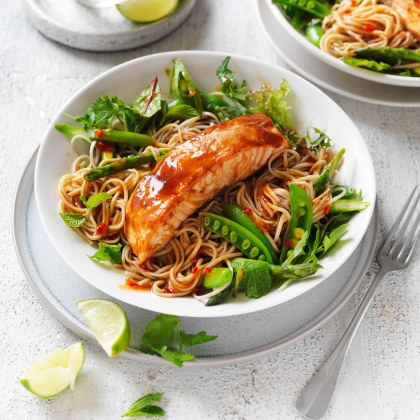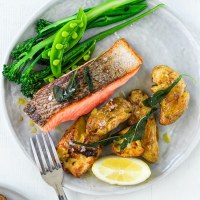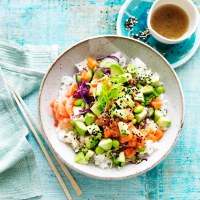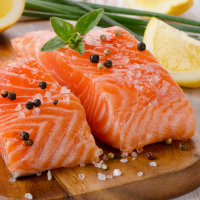The health benefits of salmon
Is salmon healthy?
Yes. Salmon is high in protein and is an excellent source of heart-healthy omega-3 fatty acids. It’s also a good source of potassium, selenium, B and D vitamins. Salmon does not contain any carbohydrates which makes it ideal for people on low-carb diets.
How much protein is in salmon?
A 100g portion contains 17- 22 grams of protein.
How much fat is in salmon?
A 100g portion contains approximately 13.3g of fat. There’s no need to worry about that number looking too high, because the fat in salmon is the heart healthy kind. Omega-3 fatty acids can help reduce inflammation in joints, especially in cases of arthritis. It can even increase brain function and reduce the possible onset on Alzheimer’s.
How much salmon should I eat?
It’s recommended that salmon makes an appearance on your plate two to three times a week. Aim for a portion size of approximately 150 grams.
Can you eat salmon skin?
Yes, in fact salmon skin is high in omega-3 fatty acids, vitamin D and B and collagen which is essential for healthy skin. Salmon skin contains over 50% protein, which builds strong bones and muscles. It’s also a good source of vitamin D and potassium.
Is raw salmon healthy?
It contains all of the health benefits of cooked salmon, but when eating it raw only use sashimi grade salmon. To qualify as sashimi grade – or “ready to eat raw” - the fish needs to meet a range of strict criteria to avoid the risk of foodborne illnesses. Ensure you ask your fishmonger if the fish you're buying is sashimi grade if you intend to eat it raw, and eat it as soon as possible.
What should I look for when buying fresh salmon?
It should have a bright and vibrant colour. The flesh should look moist and shiny, with a firm texture. Avoid fish with grey or brown blemishes and salmon that has a strong fishy smell - this means it’s past its prime. Fresh salmon will have a fresh, salty sea smell.
What should I look for when it comes to frozen salmon?
This is a tricky one because it’s not always easy to see through packaging and you won’t know until it has been unwrapped. Salmon fillets should be frozen solid with an even colour and no discoloured patches caused by freezer burn, which turns the flesh around the edges dry and lightens the colour of the fish. Check for ice crystals forming across the fillet. It means that the fish has been frozen, thawed and frozen again which will result in a loss of moisture and quality.
Salmon recipes
Now you know how great salmon is for your health, it's time to get some on your plate. These are some nutritious and tasty ways to eat salmon no matter the season.
GET THE RECIPE: Green Thai Curry Salmon by Passage to Asia
GET THE RECIPE: Teriyaki Salmon Soba Noodle Salad by Celebrate Health
GET THE RECIPE: Honey Sriracha Salmon with Sesame Rice by Rosella














